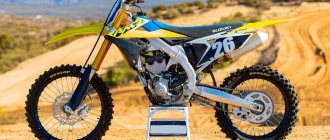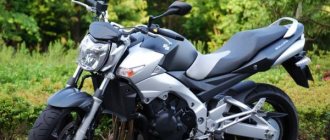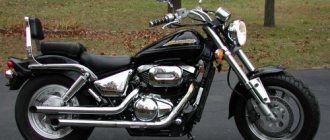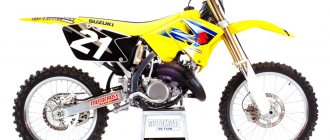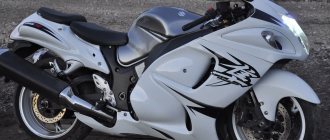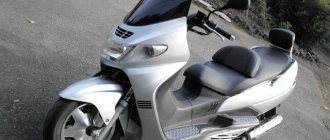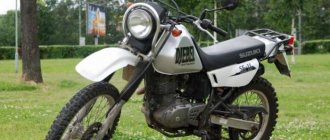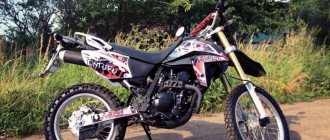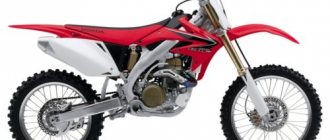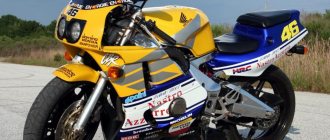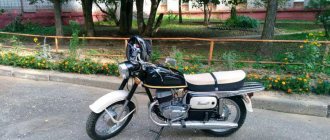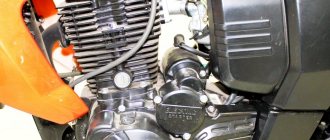Disadvantages of the model
- Driver height restrictions. The motorcycle is small enough to fit the average man.
- The speed does not exceed 115 km/h. For city conditions, this is, in principle, sufficient, but outside the city, the bike is significantly inferior to its competitors.
For decades, the Suzuki Savage 650 has been popular among girls and novice bikers. The bike is not suitable for the professional category due to its miniature size, low power and speed. However, Suzuki savage is more susceptible to tuning than others, which significantly improves its performance. Few motorcycles can boast that they have been produced in almost original form for more than twenty years.
Imagine a huge American cruiser with a two-liter engine and obscenely thick wheels, parked next to a flock of Japanese “400” choppers. The picture is funny. “But what is the strength, brother?” - I’ll ask in the words of a movie character. In this case - in the “Japanese”: there are many of them, and they are affordable - a mere mortal can buy them. Confirmation of the “strength” is the mass of second-hand goods of the “chopper 400” class on the Russian market.
Most people associate the word “biker” with the same image: a bearded man in black leather, cutting through the American (Russian) expanses on a sparkling motorcycle with a V-shaped engine, a long fork, and a game-like exhaust sound. If some girl at a gas station, touching a strong shoulder, timidly asks, “What kind of motorcycle do you have?”, the guy will throw a toothpick from one corner of his chapped lips to the other and arrogantly say: “This is not a motorcycle. It's a chopper, baby." You cannot choose a bike based on its technical characteristics, comparing models from catalogs and looking for which of two or three devices has one more horsepower of engine power. Chopper - even more so, but the “four hundred” cannot be assessed that way at all. Choose it based on the principle of “like it or not”: your heart will not deceive you.
The only technical detail worth paying attention to is the type of final drive. On some four-hundreds it is chain driven, on others the drive shaft transmits torque to the wheel, on others it is a belt. Arguing about what is better is, again, pointless: it’s the same as deciding what is better - a sportbike or an enduro... Neither is better - they are different. The cardan requires almost no attention, is durable and reliable, but is heavier than a chain and belt and hides some of the torque. The chain drive is “faster”, but you have to constantly take care of it, which is inconvenient, for example, on long trips. A belt is even lighter, more durable and simpler, but it is often difficult to buy one to replace a worn one, except to order, and it costs more than a chain.
H
ONDA Steed 400. Characteristics of the standard model, weight - 196 kg, saddle height - 680 mm, engine power - 30 hp. at 7500 rpm, max. torque - 33 N.m at 6000 rpm, estimated price - 70,000 - 160,000 rubles.
Beautiful, reliable, affordable - these qualities have made Steed extremely popular both in Japan and abroad. True “steed drivers” are characterized by an uncontrollable craving for tuning, so you won’t find two identical Honda Steeds. In addition, the model has four main modifications: VLX, VLS, VSE and VCL. The differences are as follows: Steed VLX (generally this is the designation of the standard “Steed”, but here we mean the modification of 1999) - the front and rear suspensions have been redesigned, causing the ground clearance to decrease by 10 mm compared to motorcycles of the same model of previous years of production, the bike has been painted only in black. Steed VSE (produced since 1997) is the only model with a solid rear wheel and more spokes in the front. Steed VLS is the most “sophisticated” modification and the most beloved by “severe” bikers: the place of the telescopic fork was taken by a chrome “springer”, the diameter of the front wheel was increased from 19 to 21 inches, the saddle height was reduced to 650 mm (for the VLX model the saddle is located at 670 mm above the ground), the shape of the tank has been changed. Steed VCL - almost the same VSE, only black.
But the general characteristics of the family have remained unchanged for almost 20 years (Honda Steed has been in production since 1988): liquid-cooled V-twin, chain drive and a “tricky” rear suspension a la Softail. The engine is one of the main advantages of the model. The NC25E engine with three-valve cylinder heads was installed in the Honda Bros Product II roadster chassis. The engine was depowered by 6 hp, and the operating range was “moved” 1000 rpm “lower”. But all these are trifles, because the main thing is style.
H
ONDA VT400 Shadow. Characteristics of the Shadow Classic model, weight - 225 kg, saddle height - 675 mm, engine power - 33 hp. at 7500 rpm, max. torque - 34 N.m at 6000 rpm, estimated price - 110,000 - 240,000 rubles.
One of the most popular “four hundred” choppers. Honda engineers did not “reinvent the wheel” and used the time-tested liquid-cooled NC25E engine, once again slightly modifying and retuning it. The main drive is still chain driven. The bike is wider and longer than the Honda Steed and looks more massive. The devices are located on a large 14-liter gas tank - like those of “adults”. In addition, the sizes
The Honda Shadow 400 is exactly the same as the 750 cc model, so for larger-bodied drivers, the Shadow 400 is more comfortable than the skinny Steed. The advantage of the Shadow is a large selection of available tuning tools: 80% of the decorative parts intended for the Shadow 750 are also suitable for the “younger” model. The motorcycle was modified several times, but all changes concerned only the appearance. There is a Shadow Slasher version - it somehow looks suspiciously like a Harley-Davidson Dyna Wide Glide. Other modifications are the Shadow Aero, with deep fenders and a 2-in-1 exhaust, like the standard Shadow, and the Shadow Saber, with solid rims.
K
AWASAKI EN400. Characteristics of the standard model, weight - 186 kg, seat height - 730 mm, engine power - 43 hp. at 9500 rpm, max. torque - 33 N.m at 8000 rpm, estimated price - 80,000 - 110,000 rubles.
It's no secret that all Japanese choppers and cruisers only copy the magnificent shapes and, in some ways, even the technical content of Harley-Davidson motorcycles. But Kawasaki managed to create an original bike that stands out from the monotonous “counterfeits” of HD. The EN400 motorcycle is unusual both externally and internally. Like most choppers, the Kava has a two-cylinder engine. But not V-shaped, but in-line! The power unit of the EN400AE model once “drove” the popular sports touring GPZ400S. In the “body” of the chopper, the engine “weakened” a little, but the sacrifice was 7 hp. With. It was not brought in vain - the traction at low and medium speeds has become better. However, the Japanese engineers were not able to completely curb the perky nature of the engine (and did they even want to?). The “feature” of the motorcycle is that the rear wheel is driven by a toothed belt: this is one of the few “400” that can boast this type of final drive. The advantages of the “belt” are well known: it is reliable, unpretentious, durable and does not require attention. The downside is also no secret: according to the official Kawasaki spare parts catalog, a “native” belt costs about 15,000 rubles (with delivery to Moscow). Therefore, carefully examine this expensive consumable when buying a motorcycle, otherwise you will have to fork out almost $600 over the cost of the bike.
Another feature of the EN400 is a 6-speed gearbox, a modern and quite convenient attribute of a city motorcycle. Despite all the advantages (and there are many more of them than disadvantages), the model was not particularly popular in Japan. Although this is not an indicator of the quality of the product. After all, even the legendary Honda Super Magna V45 was not accepted by Japanese riders, which is why this magnificent motorcycle was discontinued. So understand them!
K
AWASAKI Vulcan 400. Characteristics of the standard model, weight - 223 kg, seat height - 640 mm, engine power - 33 hp. at 8500 rpm, max. torque - 32 N.m at 4500 rpm, estimated price - 85,000 - 150,000 rubles.
A good old classic... The bike is built according to all the canons of the “chopper” style: spoked wheels of different sizes, a “horned” steering wheel (which many immediately change to a dragster “stick”), a V-shaped 2-cylinder engine and a “2 into 2” exhaust system. . Unless the drive to the rear wheel is chain, but these are different canons, Japanese. The motorcycle has no special advantages, nor any disadvantages. The bike is made on the basis of the 800 cc Vulcan: the engine displacement is reduced by reducing the piston stroke from 88 mm to 62. A modification of the Vulcan Classic, made in the “cruiser” style, was also produced. Motorcycles have become iconic in Japan, but have not gained such popularity outside the country. But in Europe and America, large-volume “Vulcans” (750, 800, 900, 1500, 1600 and even 2000 cm3) are in considerable demand. The weak point of all bikes of the Vulcan family is the suspension: even on a 1.5-liter cruiser, the rear Showa shock absorbers “break through” on bumps - at any setting. However, this is a feature of all Japanese choppers, cruisers and many road bikes... The Vulcan Classic model has a small wheelbase, almost like the Honda Steed 400 - 1605 mm (for comparison: Honda Shadow 400 - 1625 mm, Suzuki Desperado 400 - 1650 mm), which makes management easier.
K
AWASAKI ZL400 Eliminator. Characteristics of the standard model, weight - 195 kg, seat height - 725 mm, engine power - 53 hp. at 12,000 rpm, max. torque - 33 N.m at 11,500 rpm, estimated price - 65,000 - 120,000 rubles.
This unusual device can hardly be classified as a chopper or cruiser; rather, it is a dragster. But still, the motorcycle is closer to the bikes of this review than to roadsters or sportbikes. The ZL family is part of a lineage of power cruisers that began a quarter of a century ago (and is notable for such irrationally attractive vehicles as the Yamaha V-Max or Honda X4.
Eliminator - “four hundred” was created for the domestic Japanese market. Which is not surprising: as always, motorcycles with an engine capacity of 600, 750 and 1000 cm3 were exported... For the dragster, the most important thing is the engine, the ZL400 received it from the GPZ400R sportbike, which today can safely be called an ancient sports tourer. Jokes aside, but the inline four has 54 hp, two overhead camshafts and a driveshaft. The Kawasaki Eliminator is a good compromise between a roadster and a chopper: a stylish and comfortable bike that can accelerate quickly and maneuver well. SE modifications were produced on 3-spoke alloy wheels (the appearance of which has long been obsolete) and the LX version - with spoked wheels, which still look attractive today. Actually, “Eliminato-ru” was not very lucky with the wheels: a 150/80-15 tire was installed at the rear, and an even more bizarre size at the front - 100/90-18... It will not be easy to find new tires on sale.
S
UZUKI Intruder 400. Characteristics of the Intruder VS model, weight - 200 kg, seat height - 685 mm, engine power - 33 hp. at 7500 rpm, max. torque - 32 N.m at 6000 rpm, estimated price - 75,000 - 100,000 rubles.
The two main modifications of the model are VS400 and VL400 Classic. The first is made in the “chopper” style, the second is in the “cruiser” style. Both of them are built in full accordance with the canons of the genres, which cannot but please fans of the classics. Traditional V-shaped 2-cylinder engine - with one overhead camshaft, but with liquid cooling and 4-valve cylinder heads. However, the engine does not have outstanding power or torque. The VS version has two weak points: mediocre brakes, which are unlikely to be able to stop the bike in an emergency (especially if a well-fed rider is driving), and also not the most convenient location of the battery. There are legends and jokes among motorcyclists about how much it costs to remove the Intruder battery. In an effort to reduce the overall parameters of the bike, the designers placed it behind the pendulum mount, and so it turned out that you can only get the battery by disassembling half the motorcycle. But both Intruders look impressive - from a distance you can’t tell whether it’s a 400 or an 800 cc machine. The Intruder VL 400 Classic model looks like all cruiser 400 class vehicles - there is no big difference between it and, say, the Vulkan 400 Classic.
S
UZUKI VZ400 Desperado. Characteristics of the Desperado X model, weight - 201 kg, seat height - 685 mm, engine power - 33 hp. at 7500 rpm, max. torque - 32 N.m at 6000 rpm, estimated price - 75,000 - 100,000 rubles.
Another dragster, this time from Suzuki. The motorcycle is light (lighter than the Kawasaki Vulcan Classic or Honda Steed by almost 25 kg) and large (its 1650 mm wheelbase is even longer than the Yamaha XVS1100 Drag Star), with a revvy engine. We can say that the temperament of the “narrow” liquid-cooled V-twin is not chopper at all: instead of savoring the thrust at low and medium speeds, behind the wheel of the Desperado there is a desire to “burn”. This is facilitated by a hard saddle, good suspension (inverted front fork!) and moderately tenacious brakes. In general, the design of the motorcycle is very modern and does not look like a hello from the 20th century, like the Kawasaki EN400 Vulcan (despite all its technical goodies). The base Desperado model has alloy wheels, a 2-in-2 exhaust, and an almost straight steering wheel a la a drag bar. It’s a rare case when a modification of a motorcycle is more popular than the base model: the Desperado X is found in showrooms much more often than the stock version of the bike, and the whole difference is in the small stylish half-fairing and lower “plough”. Since 1999, the Suzuki concern has produced a version of the Desperado Winder (rare in Russia) specifically for the Japanese market. This model is longer, wider and higher than the standard one, several kilograms lighter and very different in appearance: the front spoked wheel is thinner and larger in diameter, the engine is painted black, a regular “telescope” is installed instead of an inverted fork, and a different headlight.
SUZUKI LS400 Savage, weight - 160 kg, seat height - 160 mm, engine power - 24 hp. at 7000 rpm, max. torque - 26 N.m at 4000 rpm, estimated price - 65,000 - 90,000 rubles.
An extraordinary chopper, the Suzuki concern surprised the world when it released this bike on the Japanese domestic market 20 years ago (production began in 1987). The Savage chopper chassis is equipped with a 400 cc 4-stroke 1-cylinder air-cooled engine that transmits torque to the rear wheel via a toothed belt! So the VN400 is not the most original chopper: one cylinder and a belt are what are really original (by the way, the belt, unlike the Kawasaki one, costs 5,000 rubles, which is relatively inexpensive). The sound of a big “single-barrel gun” is just a song! With such a sound, endurists will accept you as one of their own - they are familiar with the sound of an engine of this design and volume better than others. Suzuki Savage has never been famous for its outstanding speed performance, but it is still in demand due to its amazing reliability, ease of control, and also its low weight: the bike weighs 160 kg, while, say, the Yamaha Drag Star 400 is not the most heavy chopper “four hundred” - all 204. Agree, the difference is noticeable. Because of this, Savage is especially attractive to female motorcycle riders. In 1995, the bike was slightly changed externally - the steering wheel, the shape of the mirrors and some other little things were changed. There is also a 650 cc model, which is much more popular than the “four hundred” - the Savage doesn’t cost much more, but it drives better.
YAMAHA XV400 Virago, weight - 185 kg, seat height - 720 mm, engine power - 40 hp. at 8500 rpm, max. torque - 34 N.m at 7000 rpm, estimated price - 60,000 - 95,000 rubles.
Not only Suzuki managed to create a Japanese chopper, but also Yamaha. The Virago is practically an iconic motorcycle. This is a bike with a bright character and distinctive appearance, for which it is appreciated not only in Japan, but throughout the world. The predecessor of the Virago was the Yamaha XV400 Special, which already had the following features: a raised gas tank, V-twin cylinders “hanging” in the air, a short wheelbase, a miniature cardan. The “real” Virago first rolled off the assembly line in 1988 and was produced until 1998, when the “four hundred” was discontinued. An interesting feature of the XV400 Virago: the gas tank is under the saddle. On the first version of the motorcycle (1988), the drop tank was just a decorative element, and the real fuel tank with a capacity of almost 9 liters was located under the saddle. In 1989, engineers finally turned the false tank into a real one, and from now on 4.5 liters of fuel could be filled into it (which is not so little, considering that there was still an 8.5-liter capacity under the seat). After such refinements with the fuel tank, the Virago remains a low center of gravity, which makes it easier to handle. The motorcycle is very maneuverable and dynamic, light and comfortable. The ergonomics are such that driving the XV400 feels like driving a “classic”. One “but” is the brakes: before the modernization in 1994, when the motorcycle received a second brake disc at the front, they were not at all effective.
YAMAHA XVS400 Drag Star. Characteristics of the standard model, weight - 204 kg, seat height - 650 mm, engine power - 33 hp. at 7500 rpm, max. torque - 32 N.m at 6000 rpm, estimated price - 95,000 - 140,000 rubles.
The model that replaced the popular XV400 Virago. The designers tried to take into account and correct all the shortcomings of the previous motorcycle: the Drag Star received more modern carburetors and an ignition system, suspension (at the rear, one central one took the place of two shock absorbers) and a fairly rigid long duplex frame. The motorcycle got its engine from Virago - the same air-cooled V-twin with a cylinder camber angle of 75 degrees, but modified and retuned. It's still the same driveshaft. The engine lost seven horsepower, and the bike itself gained a couple of tens of kilograms - therefore, in comparison with its famous predecessor, the Drag Star “does not move.” The brakes remain at the level of the Virago, which is not bad - the XVS400 slows down using a single disc brake (disc diameter - 298 mm) at the front and a “drum” at the rear, while Viragos of recent years were equipped with double disc brakes. The XVS400 is created in the style of American choppers - Yamaha did not make any discovery with the Drag Star model. However, the bike is attractive and elegant, looks expensive, and its impressive size is misleading: whether it’s a “liter”, “six hundred” or “four hundred” - only those well versed in the XVS model range will understand. There is a modification of the Drag Star Classic, made in the “cruiser” style: with a thick 16-inch front wheel, a large headlight and decorative fork covers, as on the HD Fat Boy, as well as a plump saddle and deep wheel fenders.
Source: https://moto72.ru/useful/639-choppery-i-kruizery-s-obemom-dvigatelja.html
"Diseases"
The Suzuki LS650 Savage is a simple and reliable motorcycle, but may have some problems associated with its technical features:
- Timing chain tensioner problems
are the most common problem. Due to design features, the timing chain tensioner may fail after 20,000 km. - Problems with the starter
- on models before 1996, the starter is not the most reliable element of the motorcycle, wear of the drive is accompanied by noise and knocking. Beginning in 1996, the Suzuki LS650 Savage received a more reliable overrunning starter design and this problem disappeared. - Corrosion
- this problem is more related to the age of the motorcycle than to its design features. - Loose Fasteners
- Due to vibration, corrosion and wear, fasteners may become loose. This is especially true for loaded components such as the belt pulley shaft. It is recommended to periodically inspect to ensure that nuts and bolts are sufficiently tightened and that loose fasteners are tightened (including using thread locker).
